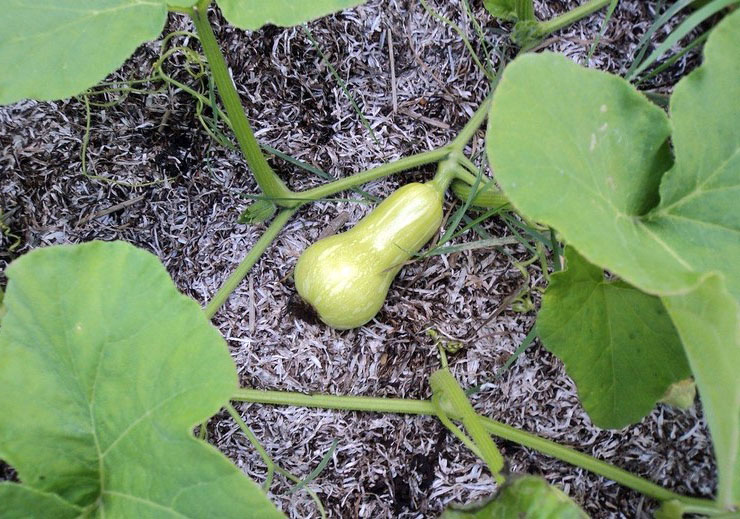When to sow butternut squash?
You sow the butternut seeds in the shelter in March, in a heated veranda or greenhouse. It's only once in the spring when the frosts are over that you put your seedlings in the garden, usually in late May or early June, in most areas. If you wish, you can put them in the ground earlier, but then you have to protect them with a plastic bell at night so that it does not freeze.
She loves the heat and to lift properly, the climate must be warm and temperate.
If you plant in a bucket, you will have to do it three weeks before transplanting it in the ground, so you do not have to sow too soon.
What to do before sowing the butternut squash?
Like all squash, butternut enjoys very rich and largely sunny soils. If you want the seeds to germinate, they need heat, it's a cold-sensitive fruit. You have to choose a fairly large part of the garden where the butternut squash can spread without disturbing the other plantations.
Put decomposed compost in a relatively large amount to enrich the soil and then dig properly. It is recommended to add manure as well.
If the soil is clayey and heavy, form mounds of enriched earth and sow the seeds on top of them.
How to sow it?
You can perfectly sow the butternut from February to April, but be careful, it must be done under shelter (greenhouse or veranda). You put them in buckets and you transplant them at the end of May, once the risks of frost are removed. You can also set them up directly in May.
The procedure consists of placing two or three seeds in the soil at a depth of 5 cm, every 80 cm to 1 meter. If temperatures are cool and fall below 18 ° C at night, cover them with a forcing veil or plastic bell to protect them. Water properly and straw the soil. Once the seeds have sprouted and two leaves appear, feel free to lighten and keep your feet strong.
Concerning the semi in pre-bucket, you will proceed as follows :
- Press 2 to 3 seeds per cup.
- During the germination period, the temperature should not be lower than 12 ° C.
- Once the plant has emerged, keep only the most vigorous plants.
- 3 weeks later, you can transplant them in the ground, if you are sure that there is no risk of frost.
- Allow 1.50 to 2 meters between each foot.
The squash is a runner, that is spread out, it is better to put it in a place where it will have sufficient space. If this is not the case, you can hang them on a support: trellis or palisade. However, once the fruit is formed, it will be necessary to support them by hanging boards or shelves to the support. They are heavy and the supports must be strong.
Where to plant butternut squash?

Butternut needs sun, heat and soil rich in humus to have a very good harvest. We must choose a sheltered and sunny place. It is better to put compost to enrich the soil. Thanks to an organic mulch made from shredded grass stalks, straw, mulch … that you have around the plant, the soil will gradually grow rich and at the same time, it will remain fresh. Moreover, as soon as the fruits form, it protects them by avoiding them being splashed by the ground as soon as it rains.
How to maintain it?
You can pinch the stems above the third or fourth leaf. This action helps to stimulate the growth of the plant and to obtain a more generous production.
When the plants are already well developed, it is recommended to mulch the foot. This prevents the squash from touching the ground and thus avoiding possible rot.
As you can see, the interview is very simple.
If cross-pollination can be provided by insects, we recommend that you obtain a generous harvest from manual pollination.
How to water butternut squash?
In summer when the fruits are formed, it must be ensured that the water supply is sufficient. If the period is dry, water every day or regularly. Watering is done at the foot of the squash without wetting the foliage. It is also necessary to hoe around the plants, hoeing is equivalent to two waterings. Since butternut is a vegetable that is very greedy, avoid planting it for two years in a row. Every other year, prefer leafy vegetables such as spinach or salads.
You will water it preferably in the morning and every day when it is hot.
Harvest butternut squash: when and how?
Depending on the region, you will harvest butternut squash between August and October. You will know that the fruit is perfectly ripe when it has a thin orange-tinged skin and when its foot turns brown. It is also possible to pick it when the leaves are dry and as long as the peduncle is dry. You can leave them in place on a plant as long as they are protected from the moisture of the soil and put in the shelter before it freezes.
After picking, you can keep the squash for several months, in a dry place and between 10 to 15 ° C maximum. Here are a few tips :
- The place should not be wet or it will not be as good.
- As soon as a part becomes soft, remove it and consume the rest quickly.
- Cut the peduncle to pruner 6 to 10 cm from the vegetable.
To note : keeping a piece of peduncle, butternut keeps much better.
The diseases of butternut squash and what to do?

The two diseases that watch for butternut are powdery mildew and gray rot :
They usually come from an excess of cold humidity. The powdery mildew appears at the beginning of the season and the gray rot rather at the end of the season. Both are treated in the same way: by spraying horsetail or nettle manure that will allow the squash to strengthen its natural defenses. If the plant has been affected, you must cut the foliage reached. If any of these diseases occur when butternuts are growing, place them on a brick or on dry straw. They must not touch the ground anymore.
The main attack to which it is exposed is that of aphids :
Signs appear between late spring and early summer. Leaves or young shoots are slightly tense or deformed and colonies of black or green aphids appear. They weaken the plants by puncturing the sap.
To remedy this, remove the aphids as soon as they begin to invade the plant with a jet of water and then put a manure of fern, or a solution of black or soft soap.
Even more plantations:









